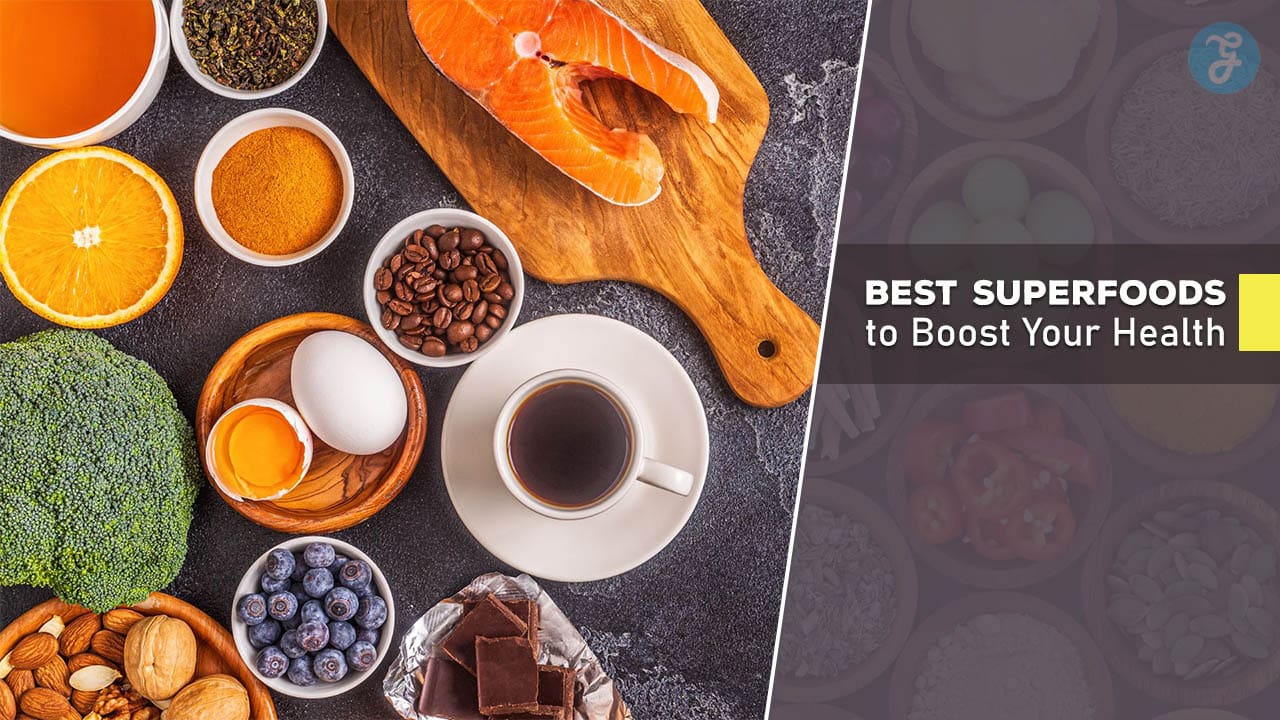Superfoods are all the rage these days. You might have heard about them, but do you know what they are and why they matter? These nutrient-rich foods pack a powerful punch for your health. They can help you feel better, look better, and even live longer.
Adding superfoods to your diet is an easy way to boost your health and well-being. You don’t need to make big changes – just add a few of these foods to your meals each day.
This list will show you 30 superfoods that can make a real difference in your life. We’ll also tell you where to find them, so you can start enjoying their benefits right away.
1. Goji Berries
Goji berries are small, red fruits packed with nutrients. You can find them dried or as juice in health food stores and some supermarkets.
These berries are rich in vitamins C and A. They also contain iron, zinc, and fiber. Eating goji berries may help boost your immune system and improve your overall health.
Some studies suggest goji berries might protect your eyes from age-related problems. They may also help you feel more calm and sleep better.
You can add dried goji berries to your morning cereal or yogurt. They also taste great in trail mix or baked goods. If you prefer, you can drink goji berry juice or tea.
While generally safe, goji berries might interact with some medications. It’s best to check with your doctor before adding them to your diet, especially if you take blood thinners.
Try snacking on a handful of dried goji berries as a healthy treat. You can also blend them into smoothies for a nutrient boost. These versatile berries are easy to include in many recipes.
2. Chia Seeds
Chia seeds are tiny powerhouses packed with nutrients. These small black or white seeds come from the Salvia hispanica plant.
You can easily add chia seeds to your diet. Try sprinkling them on yogurt or oatmeal. You can also mix them into smoothies or baked goods.
Chia seeds are rich in fiber. This helps keep you feeling full and can aid digestion. They also contain protein and healthy fats.
When mixed with liquid, chia seeds form a gel-like substance. This makes them great for making puddings or as an egg substitute in recipes.
These seeds are high in antioxidants. Antioxidants aid in preventing damage to your body from harmful molecules.
Chia seeds may support heart health. They contain omega-3 fatty acids, which are good for your heart.
You can find chia seeds in most grocery stores. Look for them in the health food section or near other seeds and nuts.
Try making a simple chia pudding. Mix 2 tablespoons of chia seeds with 1/2 cup of milk. Let it sit for a few hours or overnight.
Adding chia seeds to your meals is an easy way to boost your nutrient intake. Start with small amounts and gradually increase as you get used to them.
3. Quinoa
Quinoa is a nutritional powerhouse that deserves a spot in your diet. This ancient, grain-like seed packs a serious punch when it comes to nutrients.
You’ll find quinoa in most grocery stores these days. Look for it in the grains or health food section. It comes in different colors like white, red, and black.
Quinoa is rich in protein, with all nine essential amino acids. This makes it a great choice for vegetarians and vegans. It’s also gluten-free, so it works well for people with celiac disease or gluten sensitivity.
Fiber is another big benefit of quinoa. One cup of cooked quinoa gives you about 5 grams of fiber. This helps keep you feeling full and supports good digestion.
Quinoa contains important minerals like iron, magnesium, and zinc. It’s also a good source of B vitamins, which are key for energy production in your body.
You can cook quinoa like rice. Rinse it first, then use 2 cups of water for every 1 cup of quinoa. Bring to a boil, then simmer for 10-20 minutes until the water is absorbed.
Try using quinoa in salads, soups, or as a side dish. You can even use it in baking or as a breakfast porridge. Its mild, nutty flavor works well in many dishes.
Adding quinoa to your meals can boost your nutrient intake and add variety to your diet. It’s a versatile food that’s easy to prepare and enjoy.
4. Spirulina
Spirulina is a blue-green algae packed with nutrients. You can find it in powder or tablet form at health food stores. This superfood is rich in protein, iron, and antioxidants.
Adding spirulina to your diet may help lower cholesterol levels. It can also reduce your blood pressure, which is good for your heart health. Some studies suggest it might even have anti-cancer properties.
Spirulina contains high amounts of B vitamins and minerals. Just one teaspoon gives you iron, potassium, and protein. It’s a great choice for vegetarians and vegans looking to boost their nutrient intake.
You can mix spirulina powder into smoothies or juices. Some people sprinkle it on salads or add it to energy bars. Start with small amounts and work your way up, as the taste can be strong.
While spirulina has many benefits, it’s always best to talk to your doctor before adding new supplements to your diet. This is especially true if you have any health conditions or take medications.
5. Kale
Kale is a powerhouse vegetable packed with nutrients. This leafy green belongs to the cabbage family and comes in different varieties.
You can find kale in most grocery stores and farmers markets. Look for fresh, crisp leaves with a deep green color.
Kale is low in calories but high in vitamins and minerals. It contains vitamin C, vitamin K, and beta-carotene. These nutrients support your immune system and help keep your skin healthy.
Adding kale to your diet may help lower cholesterol levels. It’s also rich in fiber, which aids digestion and helps you feel full.
Try adding kale to soups or salads. You can also make kale chips as a healthy snack. Blend it into smoothies for a nutrient boost.
When cooking kale, try sautéing it with garlic and olive oil. You can also bake it in the oven to make crispy kale chips.
For a twist on pesto, use kale instead of basil. Mix it with walnuts, garlic, and olive oil for a tasty sauce or dip.
6. Maca Powder
Maca powder comes from a root vegetable grown in the Andes mountains. You can easily add this superfood to your diet for a health boost.
Maca powder is packed with nutrients. It contains B vitamins, iron, copper, and zinc. These help support your overall health.
Many people use maca for energy. Unlike coffee, it won’t make you jittery. You might feel more awake and focused after eating it.
Maca may also help balance your hormones. Some women find it eases PMS and menopause symptoms. Men might see improved fertility.
You can mix maca powder into smoothies or oatmeal. It has a mild, nutty taste that blends well with other flavors. Start with a small amount and work your way up.
Look for maca powder at health food stores or online. Choose organic varieties for the best quality. A little goes a long way, so a small bag can last a while.
Remember to talk to your doctor before adding new supplements to your diet. This is especially important if you have any health conditions or take medications.
7. Turmeric
Turmeric is a bright yellow spice that packs a powerful punch for your health. This root from the ginger family has been used for centuries in cooking and traditional medicine.
You can find turmeric in the spice aisle of most grocery stores. It’s available as a ground powder or fresh root. Look for organic options to avoid pesticides.
Turmeric contains curcumin, a compound with strong anti-inflammatory properties. This may help reduce pain and swelling in your body.
Adding turmeric to your diet is easy. Sprinkle it on roasted vegetables or mix it into rice dishes. You can also blend it into smoothies or make a warm turmeric latte.
For the best results, pair turmeric with black pepper. The piperine in black pepper helps your body absorb curcumin better.
Try cooking with turmeric in curries, soups, and stir-fries. Its earthy flavor adds depth to many dishes. Start with small amounts and increase as you get used to the taste.
You can also take turmeric supplements. Talk to your doctor first, especially if you’re on medications. They can help you find the right dosage for your needs.
8. Hemp Seeds
Hemp seeds are tiny powerhouses of nutrition. These small, round seeds come from the hemp plant. You can easily add them to your diet for a health boost.
Hemp seeds are packed with protein. They contain all nine essential amino acids your body needs. This makes them a great choice for vegetarians and vegans.
You’ll also find plenty of healthy fats in hemp seeds. They’re rich in omega-3 and omega-6 fatty acids. These fats can help lower inflammation in your body.
Hemp seeds are also a good source of fiber. This can aid your digestion and help you feel full longer. You might find it easier to maintain a healthy weight.
These seeds contain important vitamins and minerals too. You’ll get vitamin E, phosphorus, potassium, and magnesium. These nutrients support various body functions.
You can eat hemp seeds raw or toasted. Try sprinkling them on salads or yogurt. You can also blend them into smoothies or bake them into bread.
Look for hemp seeds at health food stores or in the health section of your grocery store. They’re often sold hulled, which means the outer shell is removed.
9. Blueberries
Blueberries are tiny powerhouses of nutrition. These small, round berries pack a big punch when it comes to health benefits.
Eating blueberries can help lower your blood pressure. A study found that eating about 3/4 cup of blueberries daily led to lower blood pressure in participants.
Blueberries are rich in fiber. This can help reduce your cholesterol levels and keep your heart healthy.
Your brain can also benefit from blueberries. They may help improve memory and keep your brain working well as you age.
These berries are full of vitamin C. A cup of blueberries gives you 14.4 milligrams of this important vitamin.
Blueberries also contain vitamin K. This vitamin is key for strong bones and normal blood clotting.
You can easily add blueberries to your diet. Try them in smoothies, on top of yogurt, or just eat them by the handful as a snack.
Look for fresh blueberries in your local grocery store or farmer’s market. Frozen blueberries are also a great option and are available year-round.
10. Acai Berries
Acai berries are small, purple fruits from the Amazon rainforest. You can find them in health food stores and some supermarkets. They’re often sold as frozen pulp, powder, or juice.
These berries pack a nutritional punch. They’re rich in antioxidants, which help protect your cells from damage. Acai berries also contain fiber and healthy fats.
You might wonder about their taste. Acai berries have a unique flavor—a mix of blackberry and dark chocolate. This makes them a tasty addition to smoothies and breakfast bowls.
One great way to enjoy acai is in a smoothie bowl. Blend frozen acai pulp with other fruits and top with granola and fresh berries. It’s a delicious and healthy breakfast option.
Acai berries may offer several health benefits. They could help reduce inflammation in your body. Some studies suggest they might support brain health and heart health too.
Remember, acai berries are just one part of a healthy diet. They’re not a miracle food. Eating a variety of fruits and vegetables is key to good health.
You can find acai products in many forms. Frozen packs are great for smoothies. Powders can be added to drinks or baked goods. Juices offer a quick and easy option.
When buying acai products, look for pure acai without added sugars. This ensures you’re getting the most nutritional benefit from these berries.
11. Matcha Green Tea
Matcha green tea is a superfood powerhouse packed with nutrients. This vibrant green powder comes from specially grown and processed tea leaves.
You can find matcha at many coffee shops, tea stores, and health food markets. It’s also available online from reputable tea companies.
Matcha offers a good dose of antioxidants called catechins. These compounds may help protect your cells from damage.
The caffeine in matcha can give you an energy boost. But it tends to release more slowly than coffee, providing sustained focus.
Some studies suggest matcha may support heart health. It could help lower “bad” LDL cholesterol and raise “good” HDL cholesterol.
Matcha contains L-theanine, an amino acid that may promote calmness. This could help you feel relaxed yet alert.
You can enjoy matcha as a hot or iced tea. It’s also great in smoothies, baked goods, and other recipes.
For the most benefits, look for high-quality ceremonial grade matcha. The color should be vibrant green, not dull or brownish.
12. Camu Camu
Camu camu is a small berry from the Amazon rainforest. It packs a powerful punch of vitamin C. In fact, it has more vitamin C than any other known fruit.
You can find camu camu as a powder, juice, or supplement. It’s rarely eaten fresh due to its very sour taste. The powder is easy to add to smoothies or sprinkle on foods.
This superfood may help reduce inflammation in your body. It could also support heart health and help manage blood sugar levels. Some people use it to fight fatigue after being sick.
Camu camu contains other good stuff too. It has antioxidants like beta-carotene and lutein. These can help protect your cells from damage.
When you’re shopping, look for pure camu camu powder or juice. Avoid products with added sugars or fillers. You can find it in health food stores or online.
Start with a small amount if you’re new to camu camu. A little goes a long way. Mix it into your morning yogurt or add it to your favorite juice for a vitamin boost.
Remember, while camu camu has many benefits, it’s not a miracle cure. It’s best used as part of a balanced diet with lots of other fruits and veggies.
13. Mangosteen
Mangosteen is a tropical fruit that packs a powerful health punch. You can find this purple-skinned fruit in Asian markets or specialty stores.
Mangosteens contain compounds called xanthones. These natural chemicals may help fight cancer cells. Some studies have shown promising results in this area.
The fruit might also help you manage your weight. Research on mice found that mangosteen could prevent weight gain on a high-fat diet.
Eating mangosteen may boost your immune system. In one study, people who took mangosteen supplements had more healthy immune cells than those who didn’t.
This fruit could be good for your heart too. It may help reduce inflammation in your body. Less inflammation means a lower risk of heart problems.
Mangosteen might also help control blood sugar. It could make your body more sensitive to insulin, which is important for managing diabetes.
To eat mangosteen, cut through the purple rind and enjoy the white segments inside. You can eat them fresh or add them to smoothies and salads.
14. Reishi Mushrooms
Reishi mushrooms are a powerhouse of health benefits. These fungi have been used in traditional medicine for centuries. They’re known for their immune-boosting properties and potential to fight cancer.
You can find reishi mushrooms in health food stores or online. They come in various forms like powders, teas, and capsules. Fresh reishi mushrooms are rare but may be available at some specialty shops.
Reishi mushrooms can help reduce inflammation in your body. This may lower your risk of heart disease and other chronic conditions. They might also improve your sleep quality and reduce fatigue.
Some studies suggest reishi mushrooms could help manage blood sugar levels. This makes them potentially useful for people with diabetes. They may also support liver health and detoxification processes.
Adding reishi mushrooms to your diet is easy. You can brew them into a tea or add the powder to smoothies. Start with small amounts and gradually increase to avoid any digestive discomfort.
While generally safe, reishi mushrooms may interact with some medications. Talk to your doctor before using them, especially if you’re on blood thinners or have a bleeding disorder.
15. Black Garlic
Black garlic is a superfood that packs a powerful health punch. It’s made by aging regular garlic for several weeks. This process turns the cloves black and gives them a sweet, syrupy taste.
You’ll find black garlic loaded with antioxidants. These substances aid in shielding your body from harmful molecule damage. Black garlic has even more antioxidants than regular garlic.
Research suggests black garlic may help control blood sugar levels. This could be good news if you’re watching your glucose. It might also lower the risk of diabetes-related issues.
Some studies hint that black garlic could slow the growth of cancer cells. This includes colon, breast, and stomach cancers. But more research is needed to confirm these effects in humans.
Black garlic may boost your brain health too. Animal studies show it might protect against memory loss. It could also help shield your brain from harmful substances.
You can find black garlic in specialty food stores or online. Try adding it to sauces, spreads, or marinades. Its unique flavor can enhance many dishes.
Remember, while black garlic shows promise, it’s not a cure-all. Eat it as part of a balanced diet for the best health benefits.
16. Moringa
Moringa is a nutrient-packed superfood that can boost your health in many ways. This plant grows in tropical areas and is known for its edible leaves, seeds, and pods.
Moringa leaves are full of vitamins and minerals. They have more vitamin C than oranges and more vitamin A than carrots. The leaves also contain lots of protein, iron, and calcium.
You can add moringa to your diet in several ways. The dried leaves can be used as a powder in smoothies or sprinkled on food. Fresh leaves can be cooked like spinach or added to salads.
Moringa may help lower blood sugar levels and reduce inflammation in your body. Some people use it to improve their skin health and boost their immune system.
You can find moringa products in health food stores or online. Look for organic, high-quality powders or supplements. Fresh moringa leaves might be available at some specialty markets.
When trying moringa for the first time, start with small amounts. This will help you see how your body reacts to it. As with any new supplement, it’s a good idea to talk to your doctor first.
17. Broccoli Sprouts
Broccoli sprouts are tiny powerhouses of nutrition. These young seedlings pack a bigger punch than their full-grown counterparts.
You’ll find broccoli sprouts in health food stores or farmer’s markets. They look like small, pale green shoots with tiny leaves.
These sprouts are low in calories but high in nutrients. A cup of raw broccoli sprouts has only about 20 calories.
They’re rich in vitamins C and K. These vitamins help your body heal and keep your bones strong.
Broccoli sprouts also contain calcium and selenium. These minerals support your bones and immune system.
The real star of broccoli sprouts is sulforaphane. This compound may help fight cancer and heart disease.
Adding broccoli sprouts to your diet is easy. You can toss them in salads or sandwiches for a crunchy boost.
You can also blend them into smoothies. Their mild flavor won’t overpower other ingredients.
Growing your own broccoli sprouts at home is simple. You need seeds, a jar, and some water.
Rinse the seeds and soak them overnight. Drain the water and rinse twice a day. In about 5 days, you’ll have fresh sprouts.
Remember to eat broccoli sprouts raw. Cooking can reduce their nutritional value.
18. Baobab Fruit
Baobab fruit comes from the baobab tree, native to Africa and Madagascar. This superfood packs a powerful nutritional punch.
You’ll find baobab fruit powder in health food stores and online. It has a tangy, citrusy flavor that’s easy to add to smoothies, yogurt, or baked goods.
Baobab is rich in vitamin C. It contains more of this immune-boosting vitamin than oranges. This helps your body fight off infections and stay healthy.
The fruit is also high in fiber. This aids digestion and helps you feel full longer. It’s great for maintaining a healthy weight.
Baobab provides important minerals like potassium, magnesium, and iron. These support heart health, muscle function, and oxygen transport in your body.
You can enjoy baobab’s antioxidant benefits too. These compounds protect your cells from damage and may help prevent chronic diseases.
Try adding a spoonful of baobab powder to your morning oatmeal or post-workout shake. It’s an easy way to boost your nutrient intake and support your overall health.
19. Flaxseeds
Flaxseeds are tiny powerhouses of nutrition. These small brown or golden seeds pack a big health punch. You can find them in most grocery stores and health food shops.
Flaxseeds are rich in omega-3 fatty acids. These good fats help your heart and brain. They may also lower inflammation in your body.
These seeds have lots of fiber. Fiber helps you feel full and keeps your digestion smooth. It’s good for your gut health too.
Flaxseeds contain lignans. These plant compounds may help fight cancer and balance hormones. They also act as antioxidants in your body.
You can eat flaxseeds whole, ground, or as oil. Grinding them makes it easier for your body to use their nutrients. Try sprinkling them on yogurt or adding them to smoothies.
Flaxseeds are high in protein. This makes them a great choice for vegetarians and vegans. They can help you build and repair muscles.
These seeds may help control blood sugar levels. This is good news if you’re watching your weight or have diabetes. They might also lower blood pressure.
Flaxseeds are easy to add to your diet. You can bake them into bread or muffins. Or mix them into your morning oatmeal. Just a small amount each day can boost your health.
20. Cacao Nibs
Cacao nibs are small pieces of crushed cacao beans. They’re packed with nutrients and offer many health benefits.
These little bits are rich in antioxidants called flavonoids. Flavonoids can help your heart by lowering blood pressure and improving blood flow.
Cacao nibs contain lots of fiber. This helps keep your digestion running smoothly. Fiber can also make you feel full, which may help with weight control.
You’ll find magnesium in cacao nibs too. This mineral is important for over 300 processes in your body. It helps your muscles and nerves work well.
Cacao nibs are a good source of protein and healthy fats. These nutrients can help you stay energized throughout the day.
Unlike chocolate bars, cacao nibs are low in sugar. This makes them a healthier choice for snacking or adding to recipes.
You can use cacao nibs in many ways. Try sprinkling them on yogurt or oatmeal. Add them to smoothies for extra crunch and nutrition.
Baking with cacao nibs is another great option. They can add a chocolatey flavor to muffins or cookies without the extra sugar.
Remember, cacao nibs have a strong, bitter taste. Start with small amounts if you’re not used to their flavor. You might grow to love their unique taste over time.
21. Maqui Berries
Maqui berries are small, dark purple fruits from South America. You might not have heard of them before, but they’re becoming more popular.
These berries are packed with antioxidants. They aid in preventing harm from harmful molecules to your body.
Maqui berries may help with blood sugar control. This can be good for people with diabetes or those at risk.
You might find maqui berries helpful for your eyes. They contain compounds that could improve eye health and reduce dryness.
These berries might also support weight loss. They can make you feel full and may help your body burn fat.
You can find maqui berries in health food stores. They’re often sold as powder, juice, or supplements.
Try adding maqui berry powder to smoothies or yogurt. It’s an easy way to boost the nutrition of your snacks.
Remember to talk to your doctor before adding new supplements to your diet. This is especially important if you take medications.
22. Bee Pollen
Bee pollen is a superfood packed with nutrients. It’s made up of tiny granules that bees collect from flowering plants. These granules contain over 250 different substances that can benefit your health.
You’ll find protein, carbs, and fats in bee pollen. It also has vitamins, minerals, enzymes, and antioxidants. This mix of nutrients can give your body a boost in many ways.
Bee pollen may help with allergies. Some people use it to reduce allergy symptoms like sneezing and itchy eyes. It might also support your immune system and help you fight off illnesses.
If you’re looking for more energy, bee pollen could help. It’s used as a natural energy tonic. This superfood might also help your body handle stress better.
You can find bee pollen at health food stores or online. It comes in different forms like granules, capsules, or tablets. Many people add the granules to smoothies or sprinkle them on yogurt.
Start with a small amount if you’ve never tried bee pollen before. Some people may be allergic to it, especially if they’re allergic to bee stings. Always check with your doctor before adding new supplements to your diet.
23. Sacha Inchi Seeds
Sacha inchi seeds are a nutritious superfood you might want to add to your diet. These nut-like seeds come from a plant grown in Peru and other parts of South America.
You’ll find sacha inchi seeds packed with protein. They have more protein than most other nuts and seeds. This makes them great for vegetarians and vegans looking for plant-based protein sources.
These seeds are also rich in omega-3 fatty acids. Omega-3s are good for your heart and brain health. Sacha inchi seeds have even more omega-3s than many types of fish.
You can eat sacha inchi seeds raw or roasted as a snack. They have a nutty flavor that many people enjoy. You can also sprinkle them on salads or add them to smoothies.
Sacha inchi oil is another way to use these seeds. You can use it for cooking or as a salad dressing. The oil keeps many of the seeds’ health benefits.
Some studies suggest sacha inchi seeds may help with weight loss. They’re high in fiber, which can make you feel full. They also have few carbs, which some people find helpful for weight control.
You can find sacha inchi seeds in health food stores or online. They’re becoming more popular as people learn about their benefits.
24. Lucuma
Lucuma is a fruit native to South America that’s gaining popularity as a superfood. You can find it as a powder in health food stores and online.
Lucuma powder has a sweet, caramel-like flavor. You can use it as a natural sweetener in smoothies, baked goods, and desserts.
This superfood is packed with nutrients. It contains vitamins B and C, iron, zinc, and beta-carotene. These nutrients support your immune system and overall health.
Lucuma may help control blood sugar levels. Some studies suggest it can prevent blood sugar spikes after meals. This makes it a good choice for people watching their sugar intake.
The beta-carotene in lucuma is good for your skin. It acts as an antioxidant, fighting free radicals that can cause premature aging.
You can easily add lucuma to your diet. Try sprinkling the powder on oatmeal or yogurt. You can also mix it into your protein shakes for extra flavor and nutrients.
Lucuma is versatile in the kitchen. Use it to make healthy ice cream, puddings, or raw desserts. It adds sweetness without the need for processed sugar.
25. Wheatgrass
Wheatgrass is a nutrient-packed superfood made from the young shoots of wheat plants. You can find it in health food stores, juice bars, and some grocery stores.
It’s often sold as a powder, juice, or in its fresh grass form. You can add wheatgrass powder to smoothies or mix it with water. Fresh wheatgrass is typically juiced or used in shots.
Wheatgrass is rich in vitamins A and C, which support your immune system. It also contains chlorophyll, giving it its bright green color and potential detoxifying properties.
This superfood may help with digestion. Its fiber content can promote regular bowel movements and support a healthy colon.
Some studies suggest wheatgrass could slow the growth of cancer cells, particularly in mouth and colon cancers. However, more research is needed to confirm these effects.
Wheatgrass might improve your mental function and reduce anxiety. Its protective effects on the brain could help with cognitive function.
When adding wheatgrass to your diet, start with small amounts. This helps your body adjust and reduces the risk of side effects like nausea or headaches.
Remember, wheatgrass isn’t a replacement for a balanced diet. It’s best used as part of a healthy eating plan that includes a variety of fruits, vegetables, and whole grains.
26. Barley Grass
Barley grass is a powerhouse superfood you might have overlooked. It’s the young, green shoots of the barley plant, harvested before the grain forms.
You can find barley grass in health food stores and online. It comes in powder, juice, or tablet form. Adding it to smoothies or juices is an easy way to boost your nutrient intake.
This superfood is packed with vitamins and minerals. It contains vitamins A, C, and K, as well as B vitamins. You’ll also get a dose of iron, calcium, and potassium.
Barley grass may help your digestion. Its fiber content can keep your gut happy and promote regular bowel movements.
Some studies suggest barley grass might support your immune system. It contains antioxidants that can help protect your cells from damage.
You might find barley grass useful for managing blood sugar levels. Research indicates it could help lower blood glucose in some people.
If you’re looking to add more greens to your diet, barley grass is a great option. It’s versatile and easy to incorporate into your daily routine.
Remember to start with small amounts if you’re new to barley grass. This will help your body adjust to the new nutrient-dense food.
27. Schisandra Berries
Schisandra berries are small red fruits that pack a big punch for your health. These berries grow on vines and come from parts of Russia, China, Japan, and Korea.
You might wonder why they’re called a superfood. It’s because they offer many benefits for your body and mind. These berries have been used in Traditional Chinese Medicine for thousands of years.
Schisandra berries can help fight tiredness and boost your energy. They may also help you think more clearly and remember things better. This makes them great for busy days when you need to stay focused.
These berries might also help your body handle stress better. They could make you feel calmer and more balanced. Some people use them to sleep better at night.
You can find schisandra berries in different forms. They come as dried berries, powders, teas, and pills. You can add the powder to smoothies or take supplements with meals.
When buying schisandra products, look for them in health food stores or online. Always check with your doctor before trying new supplements. This way, you can be sure they’re safe for you to use.
28. Seaweed
Seaweed is a superfood from the sea. It’s packed with nutrients that can boost your health. You can find different types of seaweed in many grocery stores and Asian markets.
Eating seaweed may help your metabolism and thyroid function. It’s rich in iodine, which your body needs. Seaweed also contains minerals like iron, calcium, and magnesium.
You can add seaweed to soups, salads, and rice dishes. Dried seaweed snacks are a tasty way to enjoy its benefits. Nori sheets used for sushi are another common form.
Kelp is a popular seaweed variety. It’s full of vitamins and may help prevent some diseases. You can find kelp in supplements or as a dried food product.
Seaweed farming is becoming more common. It’s seen as a sustainable food source for the future. Growing seaweed doesn’t need land or fresh water.
When adding seaweed to your diet, start small. Some types can have very strong flavors. You can try seaweed flakes as a salt substitute to ease into it.
Remember to check with your doctor before making big changes to your diet. This is especially important if you have thyroid issues, as seaweed is high in iodine.
29. Pitaya
Pitaya, also known as dragon fruit, is a superfood you’ll want to add to your diet. This vibrant fruit comes from cactus plants and boasts a unique appearance.
Pitaya is packed with nutrients. It’s low in calories but rich in vitamins C and E, plus minerals like iron and magnesium. These nutrients help support your immune system and overall health.
You’ll find fiber in pitaya too. Fiber aids digestion and helps you feel full. This makes pitaya a great choice if you’re trying to manage your weight.
Pitaya contains antioxidants that fight harmful free radicals in your body. These compounds may help protect you from certain diseases and signs of aging.
You can eat pitaya fresh or frozen. Look for it in grocery stores or specialty markets. Some stores also carry pitaya powder or freeze-dried options.
Try adding pitaya to smoothies for a colorful boost. You can also use it in fruit salads or as a topping for yogurt or oatmeal. Its mild, slightly sweet taste pairs well with many foods.
30. Coconut Water
Coconut water is a refreshing drink packed with nutrients. You can find it in the fruit section of many grocery stores. Look for fresh coconuts or bottled versions.
This natural beverage is low in calories but rich in electrolytes. It contains potassium, magnesium, and sodium. These minerals help keep you hydrated.
Coconut water may help lower your blood pressure. It’s a good source of potassium, which can reduce sodium’s effects on blood pressure.
You might like coconut water after exercising. It can replace fluids and electrolytes lost through sweat. It’s a tasty alternative to plain water or sports drinks.
Some people drink coconut water to prevent kidney stones. It may help flush out your urinary system. But more research is needed to prove this benefit.
Coconut water contains antioxidants. These substances prevent harmful molecules from causing harm to your body. This might help protect your cells.
You can enjoy coconut water on its own or mix it into smoothies. Some people use it in cooking or baking too. It adds a subtle coconut flavor to dishes.
Remember to check the label when buying packaged coconut water. Some brands add sugar or other ingredients. Choose pure coconut water for the most health benefits.
Health Benefits of Superfoods
Superfoods pack a powerful punch of nutrients that can boost your health in many ways. They offer more bang for your buck when it comes to nutrition.
Nutrient Density Explained
Nutrient density means getting lots of good stuff in a small amount of food. Superfoods have more vitamins, minerals, and other healthy compounds than regular foods. For example, kale has way more vitamin C than an orange. Berries are full of stuff that fights disease. Salmon gives you healthy fats that your body needs.
Eating nutrient-dense foods helps you get what you need without too many calories. This can help you stay at a healthy weight. It also means your body gets fuel to work its best.
Antioxidants and Their Role
Antioxidants are like superheroes in your body. They fight off bad guys called free radicals. Free radicals can damage your cells and lead to health problems.
Many superfoods are packed with antioxidants. Berries, dark leafy greens, and dark chocolate are great sources. These foods can help:
- Slow down aging
- Protect your heart
- Lower cancer risk
- Keep your brain sharp
Eating a mix of colorful fruits and veggies gives you a wide range of antioxidants.
Boosting Immunity with Superfoods
Your immune system keeps you healthy by fighting off germs. Superfoods can give it extra power. Foods high in vitamin C, like citrus fruits and bell peppers, are great for immunity.
Other immune-boosting superfoods include:
- Garlic
- Ginger
- Spinach
- Yogurt with live cultures
These foods have stuff that helps your body make more germ-fighting cells. They also reduce inflammation, which can weaken your immune system.
Eating superfoods regularly can help you stay healthy and fight off colds and flu better.
Incorporating Superfoods into Your Diet
Adding superfoods to your meals is easy and can greatly boost your health. Here are some simple ways to get more of these nutritious foods into your daily routine.
Meal Planning Tips
Start by making a list of superfoods you enjoy. Pick 3-5 to focus on each week. Add them to your grocery list and buy fresh or frozen options. Plan your meals around these foods. For breakfast, try oatmeal with berries. At lunch, add leafy greens to your sandwich or salad. For dinner, include a side of beans or sweet potatoes.
Keep superfoods visible in your kitchen. Put fruit in a bowl on the counter. Store cut veggies at eye level in the fridge. This makes it easier to grab them for snacks or cooking.
Try new recipes that use superfoods as main ingredients. Look for dishes that combine several superfoods for maximum benefits.
Superfood Smoothie Recipes
Smoothies are a quick way to pack in lots of nutrients. Here’s a simple recipe to try:
- 1 cup spinach
- 1/2 cup blueberries
- 1 banana
- 1 tbsp chia seeds
- 1 cup almond milk
Blend until smooth. You can swap ingredients based on what you have. Try kale instead of spinach or strawberries instead of blueberries.
For a green smoothie, use:
- 1 cup kale
- 1/2 avocado
- 1 green apple
- 1 tbsp flax seeds
- 1 cup coconut water
These recipes are easy to adjust. Add protein powder or Greek yogurt for extra protein. Use frozen fruit for a thicker texture.
Superfoods for Every Meal
Breakfast: Add berries to cereal or yogurt. Spread avocado on whole grain toast. Sprinkle chia seeds on oatmeal.
Lunch: Make a salad with leafy greens, nuts, and seeds. Add beans to your soup or sandwich.
Dinner: Serve salmon with a side of broccoli. Use quinoa as a base for stir-fries. Roast sweet potatoes as a healthy side dish.
Snacks: Munch on almonds or walnuts. Dip carrot sticks in hummus. Enjoy a small piece of dark chocolate.
By adding superfoods to each meal, you’ll boost your nutrient intake throughout the day. Start small and try new foods often to find what you like best.
Purchasing Quality Superfoods
Finding high-quality superfoods is key to getting the most health benefits. Here are some tips for buying the best superfoods and where to find them.
Organic vs. Non-Organic
Organic superfoods are grown without synthetic pesticides or fertilizers. They often have more nutrients and fewer chemical residues. Look for the USDA Organic seal when shopping.
Non-organic options can still be nutritious and cost less. Wash non-organic produce well before eating. Some “clean” non-organic foods with low pesticide levels include avocados, sweet corn, pineapples, onions, and frozen peas.
Choose organic foods for foods you eat often or those with edible skins, like berries and leafy greens. Go for non-organic foods occasionally or for foods with thick peels you don’t eat.
Local Markets and Farm Stands
Farmers markets and farm stands offer fresh, seasonal superfoods. You can often find unique varieties that are not sold in stores. Talk to farmers about their growing practices.
Look for vibrant colors and firm textures when choosing produce. Smell fruits to check for ripeness. Ask for samples to taste before buying.
Many markets accept SNAP benefits and offer deals on bulk purchases. Some have loyalty programs with perks for regular shoppers. Bring reusable bags to carry your haul home.
Online Retailers and Brands
Many online shops sell high-quality superfoods. Look for retailers that specialize in health foods or organic products. Read customer reviews before ordering.
Check the sourcing information for each product. Good brands share details on where and how foods are grown or made. Look for certifications like Fair Trade or Non-GMO Project Verified.
Compare prices across sites. Sign up for email lists to get coupons and sale alerts. Buy in bulk to save money on shelf-stable items like nuts, seeds, and dried fruit. Store these properly to keep them fresh longer.
Final Thoughts
Incorporating superfoods into your daily diet is a powerful way to enhance your overall health and well-being.
These nutrient-dense foods provide a wealth of vitamins, minerals, and antioxidants that can help you feel better, look better, and potentially live longer.
By knowing where to find these superfoods and how to add them to your meals, you can easily boost your nutrition and enjoy the benefits they offer.
Remember, the key to a healthy diet is variety, so mix and match these superfoods to keep your meals exciting and nutritious.
Whether you’re looking to improve your energy levels, support your immune system, or simply eat more mindfully, this guide provides all the tools you need to make superfoods a delicious and rewarding part of your life.








































